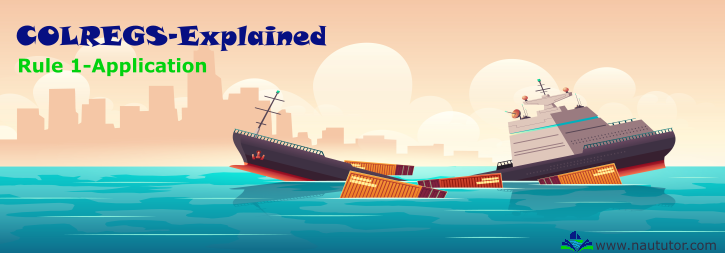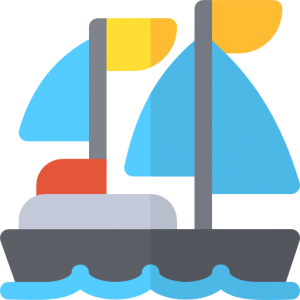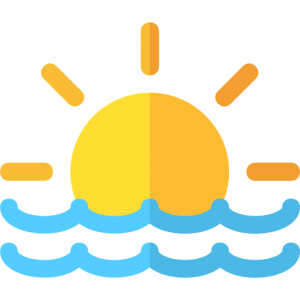Page Contents
COLREGS-International Regulations for Preventing Collisions at Sea Explained For Exams
Rule 1-Application (of the rules) explained
Before start reading the below topic make sure that you are familiar with the rules and important terms associated with the rules. if you don't; go to previous topics - ror-explained
Firstly, go through the rules,
Rule 1-Application
a) These Rules shall apply to all vessels upon the high seas and in all waters connected therewith navigable by seagoing vessels.
b) Nothing in these Rules shall interfere with the operation of special rules made by an appropriate authority for roadsteads, harbours, rivers, lakes or inland waterways connected with the high seas and navigable by seagoing vessels. Such special rules shall conform as closely as possible to these Rules.
c) Nothing in these Rules shall interfere with the operation of any special rules made by the Government of any State with respect to additional station or signal lights, shapes or whistle signals for ships of war and vessels proceeding under convoy, or with respect to additional station or signal lights or shapes for fishing vessels engaged in fishing as a fleet. These additional station or signal lights, shapes or whistle signals shall, so far as possible, be such that they cannot be mistaken for any light, shape or signal authorized elsewhere under these Rules.
d) Traffic separation schemes may be adopted by the Organization for the purpose of these Rules.
e) Whenever the Government concerned shall have determined that a vessel of special construction or purpose cannot comply fully with the provisions of any of these Rules with respect to the number, position, range or arc of visibility of lights or shapes, as well as to the disposition and characteristics of sound-signalling appliances, such vessel shall comply with such other provisions in regard to the number, position, range or arc of visibility of lights or shapes, as well as to the disposition and characteristics of sound-signalling appliances, as her Government shall have determined to be the closest possible compliance with these Rules in respect of that vessel.
Explanation of Rules
 Tips: We sorted important topics below, it will help you out in exams. good luck
Tips: We sorted important topics below, it will help you out in exams. good luck
a) explanation of Rule 1 a
- All ships big or small are to follow the rules as given in Colregs.
- Like Small yachts, fishing vessels, and other barges – as long as they sail on the seas.
- All waters connected to the high seas which include major rivers, having ports on their banks and which are visited by sea-going vessels.
- ‘High Seas’ – open seas, coastal waters or waters far away from land.
- All bays, canals which are connected to the seas provided that they are sailed on by ocean-going vessels.
- However certain exemptions are given to this latter by paragraph ‘b’ of this Rule.
b) explanation of Rule 1 b
- A harbour or port authority or a country may make some special rules for their port approaches or rivers or anchorage areas; in that case, the COLREGS shall not cause confusion in having an opposing view to the rules.
- These special rules if made shall remain restricted only to the defined areas as stated “roadsteads, harbours, rivers, lakes or inland waterways”.
- The appropriate authority would be the body in control of the area concerned.
- However, the rules that a country or port makes shall not be too dissimilar to the COLREGS so as to minimise confusion and errors, thus reducing potential accidents.
- For example, such special rules exist and are applicable in inland waters of Japan and within the US. The inland rules of the US begin to apply to all traffic within 3 miles from the US coast.
c) explanation of Rule 1 c
If a country has made any special rules which may make compulsory for ships and boats to show additional station or signals or lights for warships or for fishing fleets, then these special rules will again be such that
they should not be confusing to a seagoing vessel i.e. they should not be similar to another signal in the COLREGS with a different meaning. This point covers two aspects:
- Additional station or signal lights, shapes or whistle signals – ships of war or vessels proceeding under convoy.
- Additional station or signal lights, shape – fishing vessels engaged in fishing as a fleet.
Please note 'whistle signals' clause is absent when fishing vessels engaged in fishing as a fleet. These additional provisions cannot be applied to a single fishing vessel operating alone or independently and not forming a part of 'a fleet'.
d) explanation of Rule 1 d
The IMO may decide at any time and place to impose a traffic separation scheme, which would make it easier to navigate in a major traffic area. The above Traffic Separation Schemes will be for the purpose of
enhancing the effectiveness of these COLREGS.
e) explanation of Rule 1 e
If a specially constructed ship (aircraft carrier), which due to the nature of the equipment fitted does not have places where to fit the lights or shapes as required by the COLREGS as specified in the annexes, then a
government may allow these special ships to carry their lights or shapes in a different place, but it shall make sure that these are the closest deviation from the COLREGS. That is they are almost similar to those fitted on regular ships.
This is the main difference between paragraph 'c' and 'e', requirements developed under paragraph 'c' should have features which 'cannot be mistaken for any light, shape or signal authorised elsewhere under these Rules' and these are 'additional to the requirements stated in these Rules, Whereas the requirements developed to meet paragraph 'e' are in lieu of the requirements of these Rules or are alternate substitutes with closest possible compliance as the vessel concerned cannot comply with the prescribed standards.
read the next topic:- Rule 2-responsibility-explained
Thank you,
By Team Naututor

 Before start reading the below topic make sure that you are
familiar with the rules and
Before start reading the below topic make sure that you are
familiar with the rules and  Tips: We sorted important topics below, it will help you out in exams. good luck
Tips: We sorted important topics below, it will help you out in exams. good luck Please note 'whistle signals' clause is absent when fishing vessels
engaged in fishing as a fleet. These additional provisions cannot be
applied to a single fishing vessel operating alone or independently
and not forming a part of 'a fleet'.
Please note 'whistle signals' clause is absent when fishing vessels
engaged in fishing as a fleet. These additional provisions cannot be
applied to a single fishing vessel operating alone or independently
and not forming a part of 'a fleet'. This is the main difference between paragraph 'c' and 'e', requirements
developed under paragraph 'c' should have features which 'cannot be mistaken
for any light, shape or signal authorised elsewhere under these Rules' and these
are 'additional to the requirements stated in these Rules, Whereas the
requirements developed to meet paragraph 'e' are in lieu of the requirements of
these Rules or are alternate substitutes with closest possible compliance as the
vessel concerned cannot comply with the prescribed standards.
This is the main difference between paragraph 'c' and 'e', requirements
developed under paragraph 'c' should have features which 'cannot be mistaken
for any light, shape or signal authorised elsewhere under these Rules' and these
are 'additional to the requirements stated in these Rules, Whereas the
requirements developed to meet paragraph 'e' are in lieu of the requirements of
these Rules or are alternate substitutes with closest possible compliance as the
vessel concerned cannot comply with the prescribed standards.